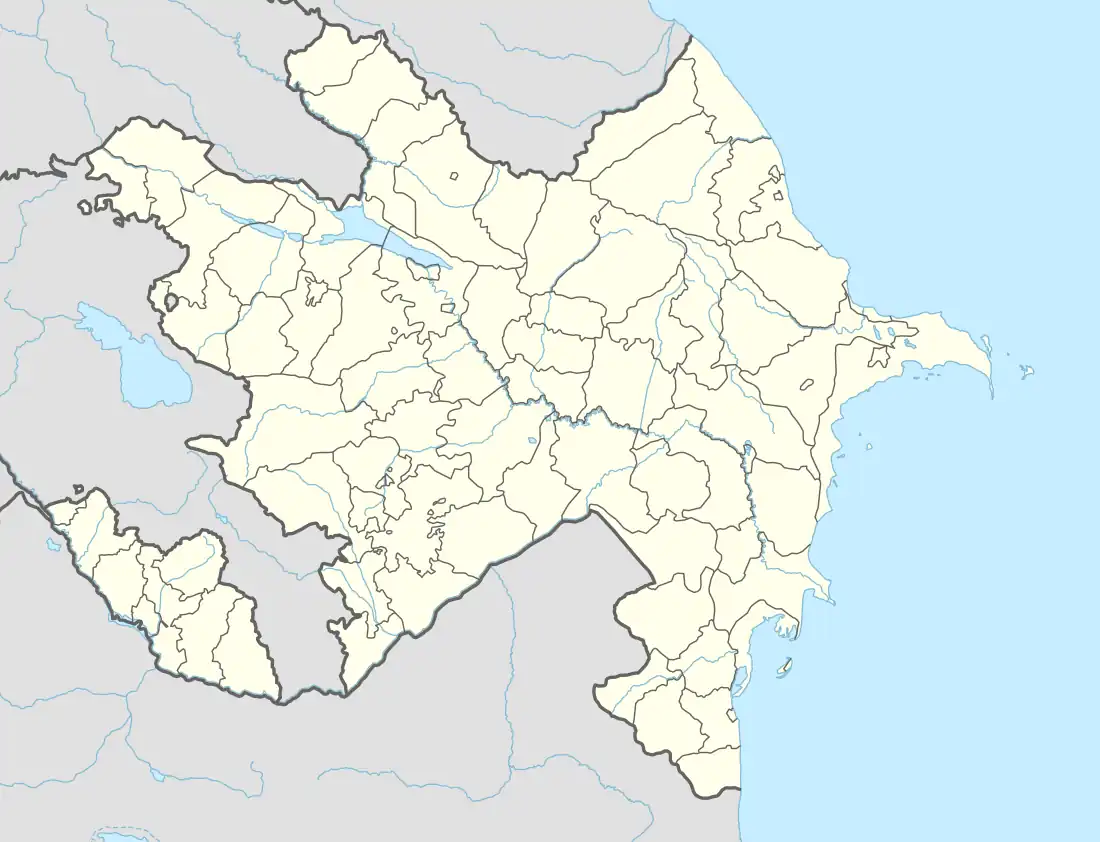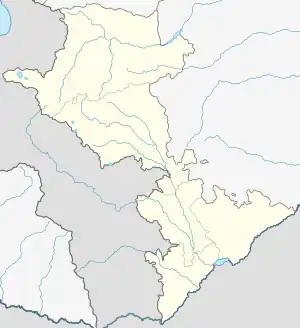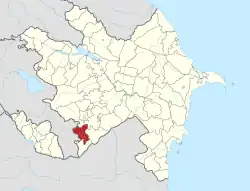Məmər | |
|---|---|
 Məmər  Məmər | |
| Coordinates: 39°15′13.2″N 46°41′37.7″E / 39.253667°N 46.693806°E | |
| Country | |
| District | Qubadli |
| Population (2015)[1] | |
| • Total | 46 |
| Time zone | UTC+4 (AZT) |
Məmər (Azerbaijani pronunciation: [mæˈmæɾ]) is a village in the Qubadli District of Azerbaijan. It is situated along the Vorotan river.
History
Məmər was part of the Zangezur Uyezd of Elisabethpol Governorate during the Russian Empire. According to 1886 census data, there were 39 homes and 165 Azerbaijanis (classified as "Tatars" in the census) of the Shiite branch of Islam in Məmər.[2] According to the 1912 "Caucasian Calendar", the village of Məmər was home to 291 people, the majority of whom were Azerbaijanis (classified as "Tatars" in the census).[3]
Məmər was part of the Qəzyan village council in the Zangilan District of the Azerbaijan SSR during the early Soviet period in 1933. The village had 52 farms and a total population of 225 people. The population of the village council, which also included the villages of Aşağı Mollu, Hal, Yuxarı Mollu, Müskənli, Qəzyan, and Rəşidli, was 55.7 percent Azerbaijani and 43.9 percent Kurdish.[4]
During the First Nagorno-Karabakh War in August 1993, Armenian forces occupied the village, forcing the Azerbaijani population to flee. It was later incorporated into the breakaway Republic of Artsakh as part of its Kashatagh Province, where it was known as Mamark (Armenian: Մամարք). Məmər was recaptured by Azerbaijan on 30 October 2020 during the 2020 Nagorno-Karabakh war.[5]
Historical heritage sites
The village is home to the 18th-century Mamar Mosque. The mosque was used as a warehouse during the Soviet era. After 1991, the mosque was reopened as a place of worship.[6] Following the village's occupation, it was taken over by Armenian forces. During the occupation, the mosque was used as a pigsty, which drew criticism from Azerbaijani officials and the Organization of Islamic Cooperation, which stated that "the deliberate destruction and looting of material and spiritual artefacts, particularly the destroyed Mosque of the recently liberated Mamar village of Gubadly District as well as misappropriation and falsification of history are a clear evidence of a policy of aggression".[7][8][9]
Demographics
| Year | Population | Ethnic composition | Source | ||||||||
|---|---|---|---|---|---|---|---|---|---|---|---|
| 1886 | 165 | 100% Tatars (i.e. Azerbaijanis) | Transcaucasian Statistical Committee[2] | ||||||||
| 1912 | 291 | Mostly Tatars | Caucasian Calendar[3] | ||||||||
| 1933 | 225 | Statistics of Azerbaijan SSR[4] | |||||||||
| August 1993: Occupation of Məmər. Expulsion of Azerbaijani population | |||||||||||
| 2015 | 46 | ~100% Armenians | NKR estimate[1] | ||||||||
References
- 1 2 Hakob Ghahramanyan. "Directory of socio-economic characteristics of NKR administrative-territorial units (2015)".
- 1 2 Свод статистических данных о населении Закавказскаго края, извлеченных из посемейных списков 1886 г. Tiflis: Transcaucasian Statistical Committee. 1893. p. 250.
- 1 2 Кавказский календарь на 1912 год [Caucasian calendar for 1912] (in Russian) (67th ed.). Tiflis: Tipografiya kantselyarii Ye.I.V. na Kavkaze, kazenny dom. 1912. p. 180. Archived from the original on 11 December 2021.
- 1 2 Административное деление АССР [Administrative divisions of the ASSR] (in Russian). AzUNKHU. 1933. p. 101.
- ↑ "Bu kəndlər də işğaldan azad edildi". Qafqazinfo (in Azerbaijani). 2020-10-30. Retrieved 2020-10-30.
- ↑ "Yol gedirəm Qubadlıya..." Ministry of Culture (in Azerbaijani). 30 October 2020. Retrieved 25 June 2022.
- ↑ "Vandalism becomes a key topic of mutual accusations between Armenia and Azerbaijan". Caucasian Knot. 16 November 2020. Retrieved 25 June 2022.
- ↑ "2020 Report on International Religious Freedom: Armenia". United States Department of State. 12 May 2021. Retrieved 25 June 2022.
- ↑ "OIC Expresses Concern over Destruction of Islamic Historical Shrines in Occupied Territories of Azerbaijan" (Press release). Organisation of Islamic Cooperation. 11 November 2020. Archived from the original on 12 November 2020.

